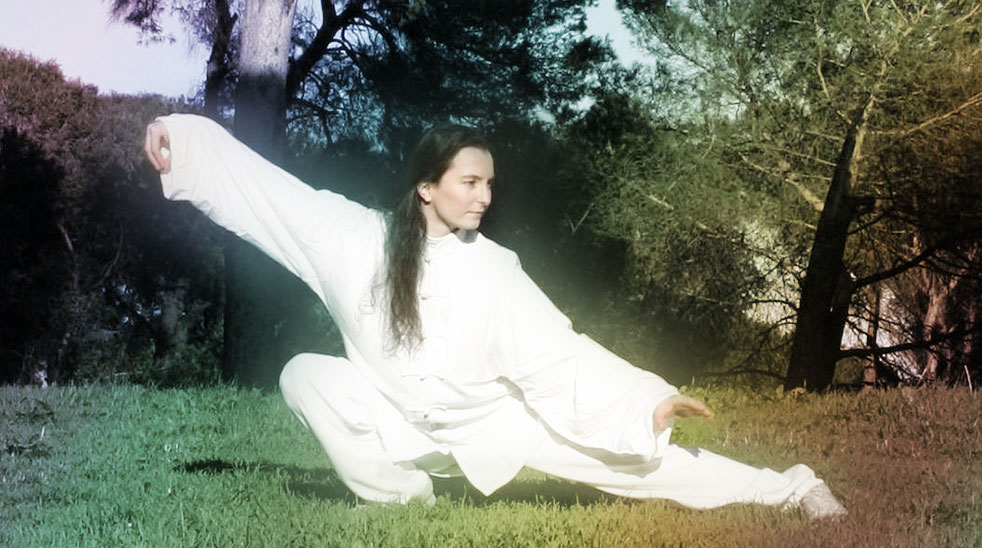
Five Principles of Tai Chi
1. Relax
2. Suspend the Head
3. Sink and Separate the weight
4. Move from the Dan Tian
5. Beautify the Hands
These are the foundations for inner power in martial arts. In the Tai Chi Classics these five principles are described as movement being, “rooted in the feet, developed in the legs, directed by the waist, guided by the breath, and manifest in the hands.” In Qigong there are three things that will always unify your movement; posture, breath, and mind. This roots your physical body, energetic body and spiritual body.
1. Relax
This principle is the foundation for all the others and a key to developing martial power. “Relax” is the hub of the wheel through which all the other principles function. The Chinese character for this principle actually contains the meaning of “relax” and “sink.” In relaxing we want to let the weight of our bodies sink into the ground. Thinking of weight as a function of gravity helps us to recognize it as a dynamic force that penetrates into the ground. In Tai Chi and Qigong this force is known as our “root.” It is important to understand that “Relax” does not mean “Collapse.” The downward movement of the weight is balanced by an upward supportive energy that reaches up through the top of the head. An analogy would be to imagine a water fountain inside the body that sends water up through the top of the head. At the same time the water from the fountain is landing on the outside of the body and dripping down. When we “relax” we feel both the upward and downward movement.
2. Suspend the Head
The way we can most fully “relax” is to “yield” to the force of gravity by aligning our bodies with it. The way we do this is using the idea of a “plumb line” (a string with a weight attached to it so it hangs along the line of gravity). We imagine a string lifting us up from the top of the head and a small weight hanging from the tailbone. This image aligns the spine, allowing the weight of the body to drop along the line of gravity all the way through the feet into the ground.
3. Sink and Separate the Weight
Also called separate Yin and Yang/full and empty/substantial and insubstantial. As we move through the Tai Chi postures, we do so by shifting the weight from one leg to the other. This is probably the most physically demanding aspect of Tai Chi. Standing on one leg, completely separating the weight will, over time, strengthen the legs. This strength in the legs brings confidence to our balance and our connection to the earth, allowing us to deepen the level of relaxation we experience in the upper body/torso. The large muscles in the legs are designed to take the weight of the body.
4. Move from the Waist – Lower Dan Tian
The waist in Tai Chi is considered the pelvis or hips, not the line above the hips where you might be fitted for a pair of pants. All turning movement in T’ai Chi comes from the hips. We have a tendency to be overly oriented to our hands and with good reason. Throughout evolutionary history the opposable thumb has served us well. However, this concentration of our awareness on the hands contributes to the tension we experience in our neck and shoulders. We often act as if the body’s “steering wheel” is the chest and shoulders. In T’ai Chi it is the hips. Not only do we want the movement to be steered by the hips, but also we want the chest and shoulders to stay aligned with them. “Eyes, nose and navel” remain in alignment at all times. Imagine your navel center as the steering wheel and allow the energy to flow from your lower Dan Tian through your torso, arms and head when you move. Relaxing and turning from the hips integrates the upper and lower body in a unified movement.
5. Beautify the Hands
The wrist is the first of the “nine gates” in the body to relax and open. This is described as keeping the wrist straight from the elbow to the tip of the middle finger. Again, this principle is closely linked to the principle of relax. Keeping the wrist straight softens and relaxes the entire arm. This facilitates the circulation all the way through the fingertips. The bent wrist acts in much the same way a fold in a garden hose restricts the flow of water through it. Keeping the wrist straight allows the movement of the legs and waist to manifest in the hands. This is described as keeping the wrist straight from the elbow to the tip of the middle finger.
Adam Apollo demonstrates these principles through a Tai Chi excerpt.
